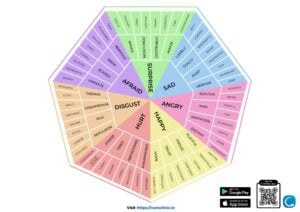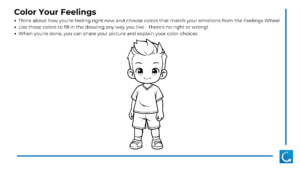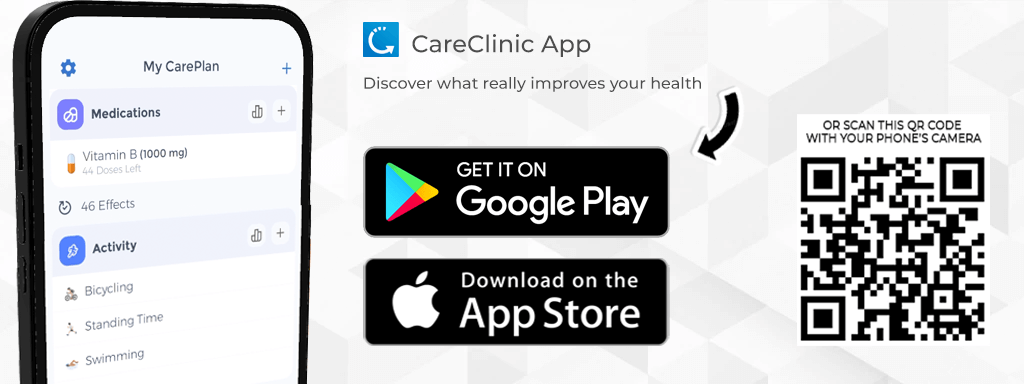
Comprehending and handling emotions adeptly can be a challenging task. Psychologist Dr. Robert Plutchik created the Feelings Wheel to help improve understanding and communication of emotions. This article delves into how a Feelings Wheel PDF can assist in emotional self-management, enhance social interactions, and be a beneficial tool in educational and therapeutic environments. We will cover three primary aspects: the definition of the Feelings Wheel, its advantages, and proper usage techniques.
Table of Contents
- What exactly is the Feelings Wheel?
- Why Use the Feelings Wheel?
- Free Printable Feelings Wheel
- How to Use the Feelings Wheel Effectively
- Improving Social and Emotional Intelligence
- Practical Applications of the Feelings Wheel
- Feelings Check-In Worksheet
- Broader Implications for Mental Health and Education
- Use the CareClinic App for enhancing your Emotional Understanding
- Download the CareClinic App to effectively integrate these tools
What exactly is the Feelings Wheel?

The Feelings Wheel is a visual tool created to assist people in recognizing and expressing their feelings. Developed by Dr. Robert Plutchik, this wheel organizes emotions into a structured layout which incorporates primary, secondary, and tertiary levels. The design of the wheel enables users to identify their precise emotional condition more accurately. This methodical method fosters a more profound grasp of one’s emotions and boosts emotional intelligence (Plutchik, 1980).
The Feelings Wheel is available in different forms, such as PDFs that can be downloaded and print-outs. To get a thorough understanding of Plutchik’s research and its significance in emotional science, refer to sources from reputable institutions like the National Institutes of Health (NIH) or articles on emotional theory in PubMed (Plutchik, R). “A comprehensive theory of emotions based on psychoevolutionary principles” (Theories of Emotion).
Why Use the Feelings Wheel?
- Improved Emotional Awareness: The Feelings Wheel enhances self-awareness and self-regulation by assisting individuals in differentiating between comparable feelings, such as “frustrated” and “angry.” A more accurate understanding and identification of emotions can facilitate their efficient management and improve general wellbeing.
- Better Communication: Effective communication relies on having a clear emotional expression language. The Feelings Wheel helps people express their emotions in the proper language, which can improve communication and avoid misunderstandings. Improved emotional communication frequently results in more fulfilling relationships and simpler dispute resolution.
- Therapeutic Applications: The Feelings Wheel is a useful tool for therapists during sessions. It offers a springboard for exploring more complex emotional problems and assists individuals in expressing their feelings.
Free Printable Feelings Wheel
Discover a new way to express and understand your emotions with our Free Printable Feelings Wheel! This handy tool is designed to help you identify and articulate your feelings more clearly, whether you’re navigating complex emotions or just need a little guidance. Download it today and start exploring the rich spectrum of your emotional world!

⬇️ Download Free Feelings Wheel
How to Use the Feelings Wheel Effectively
- Daily Check-Ins: Regularly using the Feelings Wheel can help you stay attuned to your emotional state. Each day, identify which emotions are most prominent and reflect on what might be triggering them. This practice can reveal patterns in your emotional responses and support ongoing self-awareness.
- Journaling: Incorporate the Feelings Wheel into your journaling practice. Note which emotions you experience and explore their causes using prompts like “What event led to this feeling?” or “How does this emotion influence my behavior?” Journaling with the Feelings Wheel can provide deeper insights into your emotional life and support personal growth.
- Therapy Sessions: Bring the Feelings Wheel to therapy to facilitate discussions about your emotional state. It can help articulate feelings that might be challenging to express and provide a clearer starting point for therapeutic work. The wheel can also assist therapists in guiding clients through the exploration of their emotions and developing coping strategies.
- Educational Activities: Teachers can use the Feelings Wheel to assist students in understanding and expressing their emotions. Activities might include role-playing scenarios or discussing feelings related to different situations. Using the wheel in educational settings promotes emotional literacy and empathy among students.
- Creative Projects: The Feelings Wheel can also be used creatively. For example, you might create art that represents different emotions or use the wheel in group discussions to explore collective feelings. Creative projects involving the Feelings Wheel can enhance understanding and expression of emotions in unique ways.

⬇️ Download Feelings Wheel Creative Worksheet
Improving Social and Emotional Intelligence
Gaining social and emotional intelligence is more important than ever in a world where connecting with others is frequently the key to both personal and professional success. This guide is intended to help you develop deeper, more compassionate relationships, better understand yourself and others, and handle challenging social situations with ease.
This resource will offer useful tips and tactics to develop your emotional and social abilities, regardless of your goals—whether they are to further your profession, enhance your personal life, or just become a more proficient communicator. Together, let’s go out on this path to improved self-awareness and deeper relationships.
Emotional Self-Awareness
Accurately identifying emotions is essential for emotional self-regulation, and the Feelings Wheel helps with this. According to research, correctly identifying emotions promotes better coping mechanisms and psychological health in general (Barrett, 2006). People can better handle their emotional demands and responses when they are able to differentiate between comparable emotions.
Interpersonal Communication
Emotions expressed clearly improve communication with others. Relationship disputes and misunderstandings can be avoided by using the Feelings Wheel, which offers a wide language for expressing emotions. Research suggests that enhanced emotional expression is associated with greater relationship satisfaction and more effective resolution of conflicts (Gross, 2002).
Empathy and Understanding
Using the Feelings Wheel can foster empathy by helping individuals understand others’ emotional states. In therapeutic and educational settings, recognizing and validating emotions contributes to more supportive and effective interactions. This approach aligns with findings from emotional intelligence research, which emphasizes the importance of empathy in fostering healthy relationships (Goleman, 1995).
Practical Applications of the Feelings Wheel
- Daily Emotional Check-Ins: Incorporate the Feelings Wheel into your daily routine by setting aside time each day to identify and reflect on your emotions. Use prompts such as “Which emotions are most prevalent today?” and “What events may have influenced these feelings?” Regular check-ins can enhance emotional awareness and help track changes over time.
- Journaling and Reflection: Enhance your journaling practice by integrating the Feelings Wheel. Document your emotional experiences and explore their origins using the wheel’s categories. Questions like “How do these emotions affect my daily behavior?” and “What strategies can I use to manage these feelings?” can provide deeper insights and support personal growth.
- Therapeutic Settings: In therapy, the Feelings Wheel can facilitate discussions about emotional experiences. It helps clients articulate their feelings more clearly and provides a starting point for exploring underlying issues. The wheel can also assist therapists in guiding clients through emotional challenges and developing effective coping strategies.
- Educational Environments: Teachers can use the Feelings Wheel in classroom activities to teach emotional literacy. Role-playing scenarios or discussing emotions related to different situations can help students practice expressing and managing their feelings. Teaching emotional intelligence supports overall student development and well-being.
- Creative and Group Activities: The Feelings Wheel can be used creatively to enhance emotional expression. Consider organizing group activities where participants use the wheel to discuss and visualize their emotions. Creative projects, such as art or storytelling, can also be informed by the wheel, providing a unique way to explore and communicate feelings.
Feelings Check-In Worksheet

⬇️ Printable Feelings Check-In Worksheet PDF
Broader Implications for Mental Health and Education
The Feelings Wheel’s applications extend beyond individual use. In mental health settings, it supports therapeutic goals by helping clients navigate complex emotional experiences. In educational contexts, it promotes emotional literacy and helps students develop skills for managing their emotions effectively.
Integrating the Feelings Wheel into these settings aligns with broader trends in mental health and education, emphasizing the importance of emotional intelligence and self-awareness.
Use the CareClinic App for enhancing your Emotional Understanding
The Feelings Wheel is a valuable tool for enhancing emotional understanding and communication. By incorporating the Feelings Wheel into your daily routine and utilizing complementary tools like the CareClinic app, you can improve your emotional awareness, manage your feelings more effectively, and support personal growth.
Whether you’re searching for a “free printable Feelings Wheel” or exploring the features of the CareClinic app, these resources offer practical solutions for navigating life’s emotional complexities.
Download the CareClinic App to effectively integrate these tools
By integrating these tools into your life, you can achieve greater emotional clarity and resilience. Embrace the power of the Feelings Wheel and the CareClinic app to enhance your emotional well-being and achieve your personal and professional goals. Install the app today for better tracking and management of your emotions and mood.
For further reading and resources on emotional theory and the application of the Feelings Wheel, refer to academic sources such as PubMed and articles from psychological journals. Notable references include:
- Plutchik, R. (1980). “A General Psychoevolutionary Theory of Emotion.” Theories of Emotion. Retrieved from PubMed.
- Barrett, L. F. (2006). “Solving the Emotion Paradox: Categorization and the Experience of Emotion.” Emotion, 6(1), 1-16. Retrieved from PubMed.
- Gross, J. J. (2002). “Emotion Regulation: Affective, Cognitive, and Social Consequences.” Psychophysiology, 39(3), 281-291. Retrieved from PubMed.
- Kabat-Zinn, J. (1990). “Full Catastrophe Living: Using the Wisdom of Your Body and Mind to Face Stress, Pain, and Illness.” Delta.
- Elias, M. J. (2003). “The Role of Emotional Intelligence in Education.” Educational Psychologist, 38(4), 161-166. Retrieved from PubMed.
By embracing the Feelings Wheel, you can transform your emotional understanding and navigate life’s challenges with greater clarity and effectiveness.


